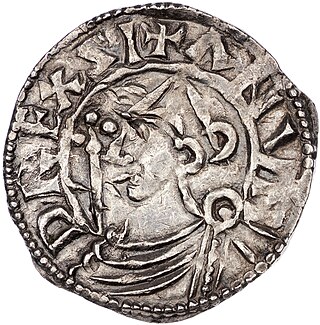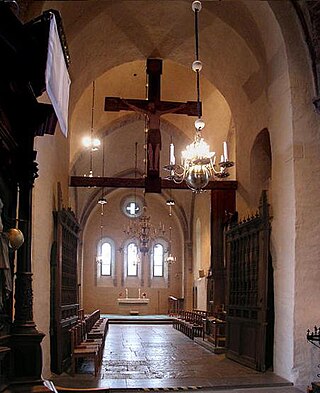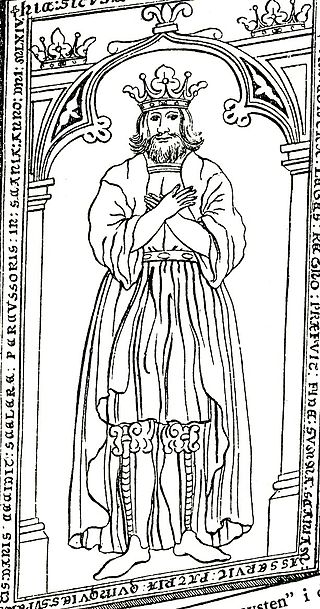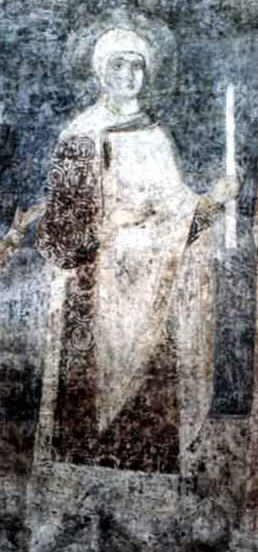Related Research Articles

Sweyn Forkbeard was King of Denmark from 986 until his death, King of England for five weeks from December 1013 until his death, and King of Norway from 999/1000 until 1013/14. He was the father of King Harald II of Denmark, King Cnut the Great, and Queen Estrid Svendsdatter.

Olof Skötkonung, sometimes stylized as Olaf the Swede, was King of Sweden, son of Eric the Victorious and, according to Icelandic sources, Sigrid the Haughty. He succeeded his father in c. 995. He stands at the threshold of recorded history, since he is the first Swedish ruler about whom there is substantial knowledge. He is regarded as the first king known to have ruled both the Swedes and the Geats, and the first king in Sweden to have minted coins. In Sweden, the reign of Olof Skötkonung is considered to mark the transition from the Viking Age to the Middle Ages. He was the first Christian king in central Sweden. Norse beliefs persisted in parts of Sweden until the 12–13th century, with some keeping the tradition into modern times.
Richeza of Poland, a member of the House of Piast, was twice Queen of Sweden and once Princess of Minsk through her three marriages. Tradition describes her as unusually beautiful.

Sweyn Estridsson Ulfsson was King of Denmark from 1047 until his death in 1076. He was the son of Ulf Thorgilsson and Estrid Svendsdatter, and the grandson of Sweyn Forkbeard through his mother's line. He was married at least two times, and fathered 20 children or more out of wedlock, including the five future kings Harald Hen, Canute the Saint, Oluf Hunger, Eric Evergood, and Niels.

Eric the Victorious was a Swedish monarch as of around 970. Although there were earlier Swedish kings, he is the first Swedish king in a consecutive regnal succession, who is attested in sources independent of each other, and consequently Sweden's list of rulers usually begins with him. His son Olof Skötkonung, however, is considered the first ruler documented to definitely have been accepted both by the original Swedes around Lake Mälaren and by the Geats around Lake Vättern. Adam of Bremen reports a king named Emund Eriksson before Eric, but it is not known whether he was Eric's father. The Norse sagas' accounts of a Björn Eriksson are considered unreliable.

Sigrid the Haughty, also known as Sigrid Storråda (Swedish), is a Scandinavian queen appearing in Norse sagas. Sigrid is named in several late and sometimes contradictory Icelandic sagas composed generations after the events the stories describe, but there is no reliable, historical evidence attesting to the veracity of her depiction in those tales. She is reported by Heimskringla to have been the wife of Eric the Victorious of Sweden, as being sought after by Olaf Tryggvasson, and then married to Sweyn Forkbeard of Denmark. In other writings, however, author Snorri Sturluson says that Sweyn the Dane was married not to Sigrid but some other woman.

Anund Jacob or James was King of Sweden from 1022 until around 1050. He is believed to have been born on 25 July, in either 1008 or 1010 as Jakob, the son of King Olof Skötkonung and Queen Estrid. Being the second Christian king of the Swedish realm, his long and partly turbulent reign saw the increasing dissemination of Christianity as well as repeated attempts to influence the balance of power in Scandinavia. Throughout his reign, he tried to subvert the rising Danish hegemony in Scandinavia by supporting the Norwegian monarchy. He also supported the reign of his brother-in-law Yaroslav the Wise in Kievan Rus. He is referred to in positive terms in German and Norse historical sources. His reign was one of the longest in Sweden during the Viking Age and Middle Ages.
Emund the Old was King of Sweden from c. 1050 to c. 1060. His short reign was characterised by disputes with the Archbishopric of Bremen over church policies, and a historically debated delimitation of the Swedish-Danish border.

Stenkil was a King of Sweden who ruled c. 1060 until 1066. He succeeded Emund the Old and became the first king from the House of Stenkil. He is praised as a devout Christian, but with an accommodating stance towards the old Pagan religion. His brief reign saw an armed conflict with Norway.
Anund from Russia was King of Sweden around 1070 according to Adam of Bremen's Gesta Hammaburgensis ecclesiae pontificum. According to this source, Anund came from Kievan Rus', presumably from Aldeigjuborg. Gårdske means that he came from Gardariki which was one of the Scandinavian names for Kievan Rus'.

Håkan the Red was a King of Sweden, reigning for about half a decade in the second half of the 11th century. There is little information on him, and it is mostly contradictory. Nothing is known about his reign.

Inge the Elder was a king of Sweden. In English literature he has also been called Ingold. While scant sources do not allow a full picture of his term of kingship, he is known to have led a turbulent but at length successful reign of more than two decades. He stands out as a devout Christian who founded the first abbey in Sweden and acted harshly against pagan practices. The kingdom was still an unstable realm based on alliances of noblemen, and Inge's main power base was in Västergötland and Östergötland; one of the earliest chronicles that mention his reign knows him as rex gautorum, king of the Geats.
Świętosława was a Polish princess, the daughter of Mieszko I of Poland and sister of Bolesław I of Poland, who married two Scandinavian kings. According to some chroniclers, this princess, whose name is not given, was married first to Eric the Victorious of Sweden and then to Sweyn Forkbeard of Denmark, giving the former a son, Olof, and the latter two sons, Harald and Cnut. Because a documented sister of Cnut seems to have borne the Polish name Świętosława, it has been speculated that this may also have been the name of their mother, the Polish princess of the chroniclers.
Gunhilda of Wenden was a Polish princess, daughter of Mieszko I of Poland according to Chronicles of Thietmar of Merserburg, Adam von Bremen and Acta Cnutonis regis princess and Danish Viking Age queen consort, the supposed spouse of 10th-century King Sweyn I of Denmark. The sources about the wife or wives of Sweyn are contradictory, and historians have debated whether she is the Polish Świętosława given another name in Norse sources.

Estrid Svendsdatter of Denmark, was a Danish princess and titular queen, a Russian princess and, possibly, duchess of Normandy by marriage. She was the daughter of Sweyn Forkbeard and perhaps Gunhild of Wenden and half-sister of Cnut the Great. By Ulf Jarl, she was the mother of the later King Sweyn II Estridson and Beorn Estrithson. The dynasty that ruled Denmark in 1047–1412 was named after her. Though never a ruler or wife of a king, she was known in Denmark as queen during her son's reign.
Gunnhildr Sveinsdóttir or Gunnhildr Haraldsdóttir, Guda or Gyda was, according to the traditional view, a queen consort of King Anund Jacob of Sweden and of king Sveinn II of Denmark. However, the sources are so vague that several modern historians maintain that there were actually two queens of that name, of Sweden and Denmark respectively. She is sometimes called Gude or Gyridje, but this is probably because of confusion with her daughter, Gyda, who is also known under her mother's name Gunnhildr.
Astrid Njalsdotterof Skjalgaätten, was a Norwegian noblewoman who married Ragnvald the Old and became the ancestress of the Swedish Stenkil dynasty. She is sometimes assumed to have been a Swedish queen, though the evidence is inconclusive.

Elisiv of Kiev was a princess of Kiev and the queen consort of Harald III of Norway.

Tyra of Denmark was a 10th-century Danish princess. She was the spouse of both King Olav I of Norway and of Styrbjörn Starke, prince of Sweden.
Tora Torbergsdatter was a Norwegian royal consort. She was the mother of two kings of Norway. It is possible, but unconfirmed, that she was also queen of Denmark or Sweden.
References
- ↑ Sven Axelson (1955), Sverige i utländsk annalistik 900-1400. Stockholm: Appelbergs, p. 34, 55-6.
- ↑ Adam av Bremen (1984), Historien om Hamburgstiftet och dess biskopar. Stockholm: Proprius, p. 189 (Book III, Scholion 66).
- ↑ Adam av Bremen (1984), p. 192 (Book III, Scholion 72).
- ↑ Hans Gillingstam, "Gunhild", Svenskt biografiskt lexikon
- ↑ P.A. Munch (1855), Det norske Folks historie, Vol. II. Christiania: Tonsbergs, p. 189.
- ↑ Adam av Bremen (1984), p. 137 (Book III, Chapter 12).